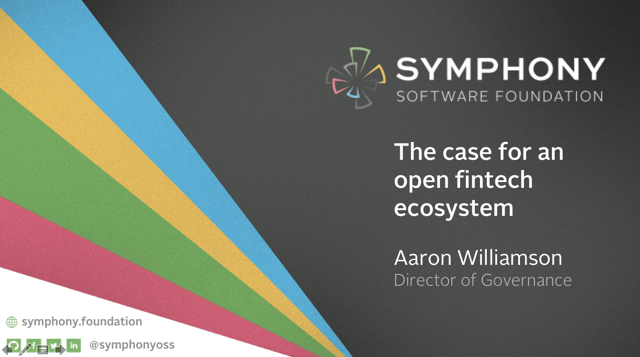
Last week at FinJS London, I had the chance to share the Foundation’s vision for an open source fintech ecosystem. As usual, our friends at OpenFin did a terrific job with the event and I had great conversations with folks from banks, startups, and vendors. Here I share my thoughts, as well as the video of the presentation.
As I shared with the FinJS crowd, the Foundation has been working for two years to bring the benefits of open source collaboration to the financial services and fintech industries. At first, we mostly heard about the challenges banks face in trying to open up: concerns about leaking valuable IP, regulations and bank policies that discourage external collaboration, and technical environments that preclude access to basic open source collaboration tools.
But that picture is changing and, more and more, Wall Street is embracing the open source vision. This year, the Foundation saw its first major contribution from a large bank: Deusche Bank’s desktop interoperability framework, Plexus. The financial press has begun to notice and report regularly on open source. And our Open Source Strategy Forum, the first conference on open source in financial services, brought in 300 attendees from financial services, fintech, and the enterprise software community.
At FinJS I talked about how open platforms benefit both platform vendors and their customers. By delivering an open source platform, vendors can:
- Commoditize their market segment out from under competitors. Rather than wrestling for a thin slice of their software’s market, the open source vendor encourages the industry to standardize on the free, open source offering, shifting the revenue model to value-add components built on top of their own platform.
- Attract contributions from their customers and the broader community. No fintech startup has the capacity to address all their customers’ requests at once. By giving banks the ability to help themselves, the vendor builds goodwill and gets a better platform.
- Scale their go-to-market strategy smoothly. Getting a bank to buy your product instead of (or on top of) a competitor’s is a tough sell. If a customer can use your product cost- and commitment-free, they’re more likely to try it, and to come back to you for service, support, and custom development.
- Focus on the core value of their platform. The are two parts of every platform: the parts everyone has to do, and the parts your platform does best. When the boring parts are a commodity and the costs of developing them are shared with customers, you can spend more time on the good stuff.
Of course the customer also benefits when you open source your core platform--and increasingly, they’ll demand it. Banks want to avoid being locked in to a single vendor for business-critical applications. They want lower total costs of ownership, because IT budgets are tightening. They want to be able to integrate tools into their existing workflows. They want to fix problems and add features that are important to them. And they want to be able to determine for themselves that the software they’re using is secure and compliant. They get all of this with open source.
Interested in learning more? Join us at our next monthly open source fintech meetup on February 12 in NYC.


